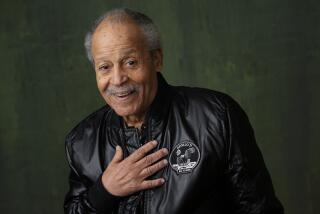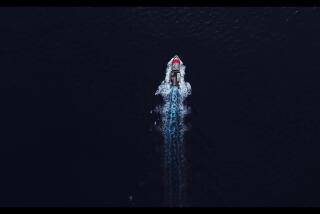Endeavour crews remember shuttle as a home and workplace
The space shuttle Endeavour drank in fuel on its launchpad, condensation rising off its metal body as gases leaked through vent ports. It seemed to astronaut Andrew Thomas like an animal poised to pounce.
“It’s almost breathing,” he said. “You have a sense that it’s a creature that’s coming to life.”
When it did, the rocket boosters roared and clouds plummeted into the distance. Endeavour was going from zero to 17,500 mph in 8 1/2 minutes.
“It is without a doubt the ride of your life,” said Thomas, who flew aboard Endeavour twice.
PHOTOS: Space shuttle Endeavour 1991-2012
A total of 139 astronauts have logged miles on this shuttle fashioned out of titanium, silicon and ceramics. It holds the memories of 20 years’ journeying through space: a collection of daring exploits, workplace antics and stellar sights burned into their minds.
For these astronauts, even the most mundane moments — sitting on the shuttle’s toilets or trying to play cards in space — are meaningful.
After traveling nearly 123 million miles on 25 missions, Endeavour is now on its final journey, set to arrive at the California Science Center on Saturday.
It’s a bittersweet occasion for the 172,000-pound machine that astronauts see as part lifeboat, part hauling van and part hotel room — with a view that’s out of this world.
::
Though the U.S. space shuttles were all meant to be the same, Endeavour was different.
The youngest and sleekest of the fleet, it lacked the wear and tear of the other spacecraft. There were no sticky switches or scuff-marked metal surfaces, said astronaut Mike Fincke, who flew on Endeavour’s final mission in 2011.
No matter how hard he looked, he could find only one flaw — a digital clock display with a broken “8.”
“Endeavour was almost perfect,” Fincke said.
Endeavour came from unusual beginnings, built with spare parts after the shuttle Challenger was destroyed in 1986.
Named after the HMS Endeavour, which bore 18th century British explorer Capt. James Cook across the seas, it was a Cadillac of space flight. Fincke marveled at its vast legroom compared with the Russian Soyuz spacecraft, which stuffed astronauts into the fetal position during launch.
PHOTOS: Endeavour’s final journey
Fincke loved Endeavour’s windows, freshly installed before its final mission. They sharpened the already-beautiful views with a new crispness.
He savored the scent of the shuttle in the same way drivers relish that new-car smell.
“The space station has a very neutral smell to me, but the shuttle has a slight metallic twang,” Fincke said. “Words can’t describe that particular blend.”
The shuttles were designed as cargo vans, and of the five shuttles sent into space, Endeavour fulfilled its missions with distinction. It carried tools to repair the Hubble Space Telescope, brought a $2-billion cosmic-ray detector into space and ferried supplies to the International Space Station.
It also carried astronauts’ own precious cargo: family photographs, wedding rings, even centuries-old artifacts.
Thomas brought along a slim stick of wood from the HMS Endeavour on his first bone-jarring ride in 1996.
“That would have blown Capt. Cook’s mind,” Thomas said. “That piece of wood traveled about, oh, 6 million miles.”
On Garrett Reisman’s first flight on Endeavour in 2008, he packed his high school physics teacher’s rosary beads, a Christmas card from a friend who had died in the Sept. 11 attacks and a gold chain his late father wore.
He also carried two pairs of wedding rings for his former Caltech professor Christopher Brennen. Reisman had met Brennen as a graduate student. When Brennen’s 21-year-old son died in a car accident, the two grew closer.
Reisman took the linked rings from Brennen’s marriage to his first wife, who had died of cancer, along with two Celtic crosses the professor and his wife had worn in memory of their son.
He also carried a new set of rings for Brennen’s second wedding, which took place while Reisman was in orbit.
“I was trying to thank people that had helped me along the way,” Reisman said.
There are strict limits on the number, size and mass of objects allowed on board. Nothing with resale value — old coins or collectible stamps — can make the trip. Electronics could interfere with the shuttle’s environment and are banned. Religious items are restricted.
These rules can apply in unexpected ways. Astronaut Greg Johnson found that a deck of cards was counted as 52 separate objects.
Using a loophole, Johnson still managed to bring the cards, but then found it nearly impossible to play in zero gravity.
Fincke learned what not to bring: no peanuts or other small snacks. The pieces would fly around and get stuck in hard-to-reach spots that would have to be cleaned up before landing.
::
In space, no one has time to deal with excess mess. Life aboard the shuttle is nonstop. Every 15-minute stretch is scheduled out.
Each astronaut has specific duties: building or fixing machinery on marathon spacewalks, wielding the shuttle’s robotic arm, cleaning the toilet — an onerous task typically dealt to the pilot.
At night the crew members wind down, catch up on email — and perhaps attempt some of the acrobatics that zero gravity inspires.
While Endeavour was hooked up to the International Space Station during the 2010 Winter Olympics, Kay Hire performed a figure-skating twirl while Japanese astronaut Soichi Noguchi jumped with small makeshift skis.
“Floating is one of the most wondrous parts of being in space,” said Jeffrey Hoffman, an MIT aeronautics professor who flew on the first mission to repair the Hubble Space Telescope in 1993.
Hoffman recalled climbing to the top of the telescope. From there, he could take in the whole shuttle, to the tip of its fully extended robotic arm.
“It’s still hard for me to talk about it in the past tense,” he said. “But that’s the way it goes.”
Floating did have its downsides — particularly concerning the toilet.
“Um, it’s quite complex,” Fincke said. “You have to strap yourself in, and there’s these leg stirrups, and you need to make a ‘perfect seal.’”
Most crew members preferred to sleep aboard the space station — it was roomier and quieter.
But on Endeavour’s final flight in 2011, Fincke strapped his sleeping bag to any wall in Endeavour’s mid-deck, listening to the whir of the indoor fans as he floated off to sleep.
“This was my last chance,” Fincke said.
His crewmate Greg Johnson thought it fitting that the final crew leave something behind.
According to tradition, the pilot lined his mates against the lockers and marked their heights in pencil. Freed from gravity’s pull, the spine straightens and the body lengthens an inch or two. The marks show how much they grew over their 16-day mission.
Johnson traced the pencil in black Sharpie pen. The astronauts’ final heights would be preserved forever in Los Angeles.
Mission commander Mark Kelly wasn’t having it. The Navy captain was entrusted with the ship. No flaws would be left on his shuttle.
“Mark’s face was pretty red,” Johnson said.
The astronauts racked their brains for ways to remove the permanent markings. Johnson suggested toothpaste, the only abrasive he could find on board. Kelly scoffed.
“Sure enough it worked — which I think also made him a little mad,” Johnson chuckled.
The crew scrubbed away the lines. By the time the shuttle landed, there was no trace left.
FULL COVERAGE: Endeavour’s final journey







